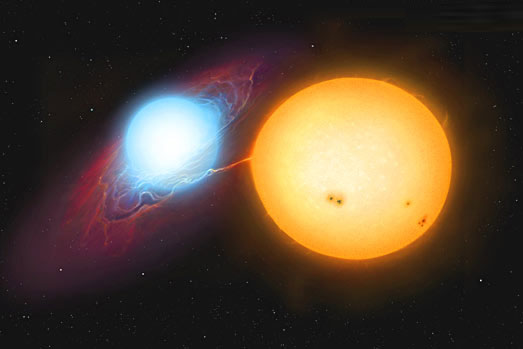'Devilish stars' appeared during the week
This week, astronomers will have the opportunity to watch 'demon stars' Algol in the sky.
Belonging to the constellation Majestic (Perseus), Algol has been called the 'demon star' since ancient times. Algol's name is derived from the word al-ghul, meaning 'female ghost' in Arabic. But contrary to many people's thoughts, this name does not refer to the star's activity, but is related to the head of the demon Gorgon Medusa in Greek mythology. In Greek mythology, Medusa is a female demon with eyes that can turn every living thing into stone.
Algol is one of the most variable ( star-changing stars ) that many people know the most and is also a very early variation. This is a typical example of a two-star model that rotates around a center, with a constant interplay of light and dark.

Illustrations of Algol star (blue) and its companion star in the constellation Zhuang Si.
The time for Algol to change from bright to dim and back to normal brightness is only nearly 10 hours. Astronomers can observe the entire activity of this star in one night if they meet the occasion.
The first person to pay attention to the starlight cycle of Algol is an astronomer living in the 17th century Geminiano Montanari in the city of Bologna (Italy), Space said.
Until 1667, astronomers only knew a single variable. It is Mira, the star of the constellation Whale (Cetus). However, the light that Mira emitted changed over a period of months, while Algol changed after only a few hours. That's probably why some astronomers at that time paid attention to Montarani's discovery.
Algol's brightness change was rediscovered in 1782 by John Goodgricke, a British amateur astronomer. Googdrike systematically observed the star and finally determined its cycle. Goodricke himself gave an explanation for this transformation phenomenon. Mira's brightness changes as it shrinks and swells. A large celestial body of low brightness revolves around Algol and this object blocks light from the star periodically.
Algol is about 93 light years from the earth and has 90 times the brightness of the sun. The object turned around, called Algol B, though darker than Algol but also three times as bright as the sun. If viewed from the Earth, we can see that Algol is completely obscured by Algol B (like an eclipse or eclipse) for a period of time.
Not only that, another object is Algol C that orbits the other pair of stars with a greater distance of 1.86 years, but is not related to stellar phenomena. Algol B obscures Algol.
As mentioned above, Algol's brightness changes every few hours. Over the years, astronomers have confirmed Algol's cycle is only a few seconds wrong. Although that change is negligible, over the years, the accumulation of changes has caused Algol's cycle to arrive a few minutes later or later.
- Devilish thorns suck water from desert sand
- 9 interesting things about stars
- Explain the mystery of missing stars in the universe
- Decoding super-fast stars in 'Ngan river'
- Detects 5 oversized stars on galaxies
- Breathtaking the sight of the stars 'circus' in the sky
- Why is the star sparkling?
- Astronomical photos last week
- Dark Star - Gift from the Universe
- Discover the dark age of the universe
- Photo universe impressive week
- Meteors cause panic in England
 Van Allen's belt and evidence that the Apollo 11 mission to the Moon was myth
Van Allen's belt and evidence that the Apollo 11 mission to the Moon was myth The levels of civilization in the universe (Kardashev scale)
The levels of civilization in the universe (Kardashev scale) Today Mars, the sun and the Earth are aligned
Today Mars, the sun and the Earth are aligned The Amazon owner announced a secret plan to build a space base for thousands of people
The Amazon owner announced a secret plan to build a space base for thousands of people The Russian space agency reported errors to Briz-M propulsion engines
The Russian space agency reported errors to Briz-M propulsion engines  Europe wants China to bring people to space
Europe wants China to bring people to space  Take a picture of the meteorite
Take a picture of the meteorite  Detecting snow on Mars
Detecting snow on Mars  Impressive photos of people
Impressive photos of people  Russia proposed setting up a space station on the Moon
Russia proposed setting up a space station on the Moon 